For many years, traditional mopeds had largely followed variations on the general theme of having pedals and employing chain drive. From the mid-1970s however, in a number of European countries, the legal definition of a moped changed from a 50cc pedal assisted machine, to a 50cc vehicle that could accommodate footrests and kick-starting means like a motor cycle, but with limited performance according to market dictates.
While manufacturers with established pedal-mopeds were facing the prospect of adapting and compromising existing designs, this might seem like an ideal time to start a new project from a blank drawing sheet and produce a fresh commuter moped to suit the new specification.
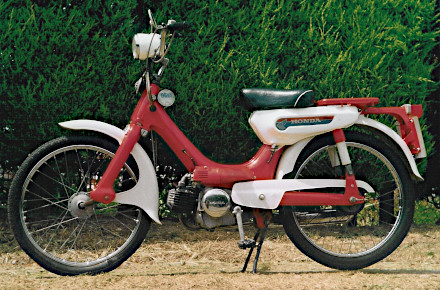
Retiring: the PC50
Our episode starts in 1977, when the Honda Motorcycle Corporation of Japan 1977 decided to retire its old PC50 four-stroke moped, and switch over to a new range of two-stroke models.
The old PC50 engine design blueprint was licensed out to American Moped Associates for further use in the AMI50 ‘Chief’ moped, while Honda went on to create and introduce their succeeding generation of machines.
With the 1973 International Oil Crisis still fresh in everyone’s minds, this new moped must be presented with a fuel-efficient motor, simple to operate, and appeal to owners with little knowledge of motor cycles.
In these enlightened times, designs were becoming increasingly influenced by marketing ideals and committee decision, meet all the criteria, every box must be ticked, and then you would inevitably end up with a machine to satisfy everyone.
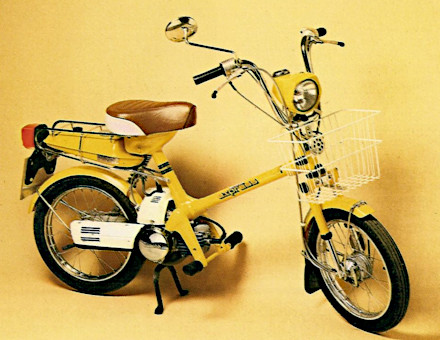
Honda Express
Photo: Ed Baxter
Some perception of the concept of this commuter moped would be the requirement for carrying capacity, so front and rear racks as standard could be economically incorporated within integral design by using them to mount other essential equipment like lamps at both ends, and maybe registration plates too?
By this time on most mopeds, Japanese manufacturers were pretty much settling on an automatic two-stroke engine with a small oil pump to cleanly self-mix lubrication into the fuel, and flashing indicators supported by a battery for the stability of a DC electrical set as standard equipment for most bikes.
Successive generations of economy mopeds seemed to have been introducing progressively smaller wheel designs (less steel & rubber materials = cheaper cost), and could the latest budget rim size now be reduced down to 14-inch?
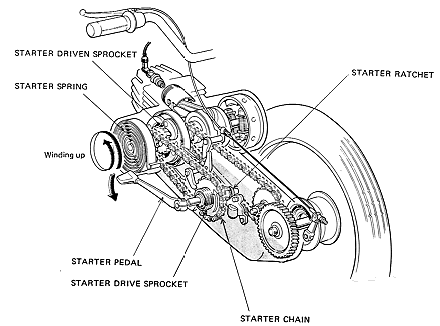
Wind-up starter mechanism
And so the process goes on, until the committee arrives at the perfect budget moped to appeal to everyone, the NC50 Honda Express—and this (we are sorry to say), is it!
Manufactured and introduced to the North American market in 1977, then further into European and the UK market in February 1978, where it was first presented as the ‘Road Express’ … (well, a new bike is going to need a good title to sell, but was ‘Express’ maybe a slight exaggeration?)
Initial versions from 1977 up to 1980 had manual choke control, contact points ignition, and a peculiar starting method that involved pumping the ‘kick-start’ three times to wind up a spring, which would release and spin the motor when the rear brake lever was pulled! If you were lucky, it might start the engine … but if the engine failed to start, then it was back to a very boring game of pump-three-times on the starter and try again.
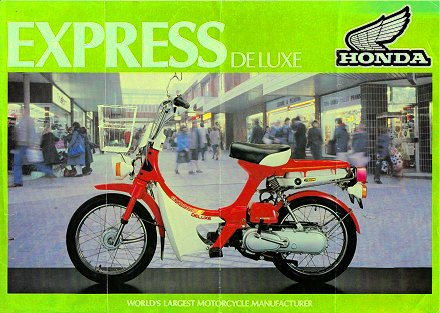
1979 brought the NA50 Express II with redesigned frame and a larger seat, which was introduced alongside the original Express model.
1980 and models with a larger battery are introduced to power signal indicator systems. A conventional kick-starter replaces the silly clockwork wind-up mechanism, CDI ignition supersedes the contact breaker set, an automatic choke device succeeds the cable control, and automatic two-speed transmission versions become available.
Our featured Express is simply marked ‘De Luxe’, was registered in 1981, and features a proper kick-starter mechanism, which features seem to relate to the NC50K-A De Luxe model, introduced in May 1980.
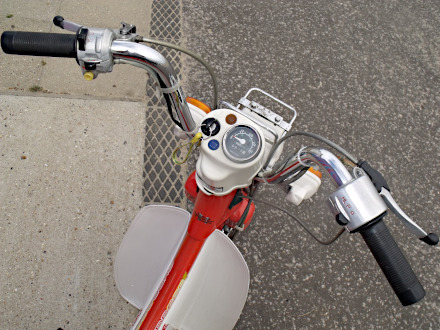
‘It’s pretty obvious where the ignition key goes…’
It’s pretty obvious where the ignition key goes since the switch is mounted right in front of you in the middle of the handlebar console, but not so the fuel tap, as it’s particularly inaccessibly tucked away under the middle front of the tank, with the tank support rails, wiring , cables, and assorted tubes in the way. It’s also a struggle to make out the tap position marking … where actually is off, on, or reserve? It’s really hard to see, and if you can’t remember which position is which, then many people will probably just end up leaving it on.
You’d have thought it’d be more practical to locate the petrol tap to one side of the tank for better access? An inexplicable and atypical Honda decision!
Another missed design opportunity would seem to be a necessity to remove the complete exhaust system to be able to remove the rear wheel, which rather makes nonsense of having the single-sided rear suspension arrangement. This still remains an all too common complaint with many modern scooters.

There’s a petrol gauge set into the top of the tank, marked E–F, and something in the level sensor quietly tinkles like an erratic clock when the fuel sloshes around.
The tank is partitioned so the lower portion acts as a pozi-oil reservoir, and there’s a sight window at the bottom left of the tank, with a little yellow ball in the porthole glass marked ‘replenish oil when yellow ball is level with arrow’ (in middle of window). Having just the single tank for petrol and pozi-oil seems like a tidy idea ... until the separating baffle fails, and we have heard of many examples, so it’s not such an uncommon problem.
There is a small forward parcel carrier, but it doesn’t look like you’d get much on it since the frame base only has a 4½" × 5½" footprint, though it does have a clamp in the middle so you can lock on a wire basket (and be the envy of your friends with such a stylish and handy accessory).
A rear carrier can be fitted above the petrol tank, but our test bike has had this removed to mount a back box.
Rims & tyres are indeed marked at the mystical size of 2¼"×14", which is a specification unique to the time, so there’s maybe another problem for the future when the last tyre manufacturer’s accountant decides the size is no longer viable (anyone trying to get 2.00–12 tyres for a Wisp, Ariel 3, or Clark Scamp will probably be well aware of the difficulty this can cause).
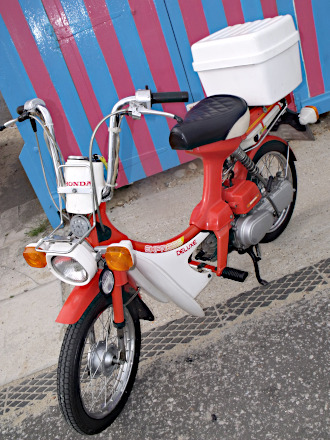
The mandatory ‘Sloped’ plate indicates weight 52kg (only 8 stone), and limited to a design speed of 30mph—and if that’s what Mr Honda says it’s designed to do, that’s very probably what we’ll get.
The three-position key switches off, ignition on, and pilot lights for parking. The thermal choke mechanism engages automatically, the kick-start with a folding head and forward action easily fires up the motor at first jab, but you’ll invariably need to leave the engine running on idle for a while until a temperature sensor on the cylinder head disengages the choking function, or it’ll pretty much die right out if you try prematurely opening the throttle.
You really do have to wait until the motor warms in its own good time, so there’ll not be many flying starts on a cold morning with one of these machines.
Initial pull off proved pretty flat, but once the engine got over the initial shock that we were expecting it to move the bike along, acceleration proved quite effective as the reed valve kicked in, up to around 25mph.
The speedo is graduated from 0–40mph, and proved very accurate to the check-readings from our pace bike.
Beyond 25mph required a little more patience as the performance was already peaking out into screaming revs. Straight away it was easy to tell that Express wouldn’t have much more to give and was going to rigidly comply with its design specification.
Best on flat, 30mph … maybe 31 on a couple of occasions on slight down-sections with a tailwind, but any speed above 30 couldn’t be maintained due to rev clipping, which flipped normal two-stroke running into a seemingly four-stroking bluster, which slowed the bike down by 2–3mph until the effect cleared again. We don’t know whether this was caused by reed-valve flutter, or a cylinder porting effect, but we have experienced the same on other two-stroke Honda models, so can only presume this to be an intentional condition to limit revs & performance to design specification.
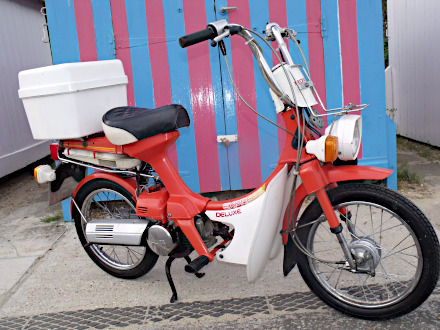
Downhill run achieved best 32mph, before the rev-clipping again reacted to slow the bike down. The following uphill climb slowed Express back to 24mph, but it felt strong and confident throughout the ascent, and there was never any doubt that it would easily and capably crest the rise under its own power. Express has no pedals, just footrests, and climbing performance becomes fairly important when the rider can’t assist, so having reed-valve induction greatly helps here.
There’s a low level of tingly vibration detectable through the footrests, but this never really increased to any level where it might be considered intrusive.
Generally the ride was comfortable enough, until you hit a bump, even in a straight line, when the bouncy back end pitched and yawed from limitations of the single-sided suspension. Handling was only adequate on smooth corners, and even the slightest bump would find Express wallowing through the bend.
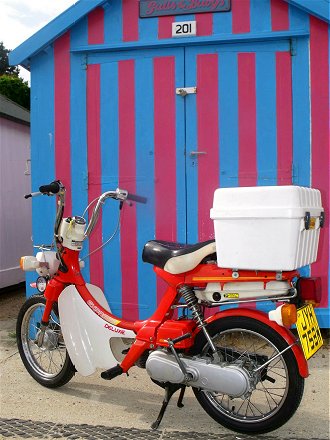
The token plastic moulded leg-shields seem barely likely to qualify as much of a weatherproofing feature, being little more than splash guards for your shoes.
Stop lighting operates from both hand levers, and both brakes proved very effective throughout the test (though hardly challenged by the restricted performance). We were a little puzzled as to any practical purpose of the secondary trigger which latches the left-hand lever to lock on the rear brake — why is that there? Presumably as some sort of parking brake, but what’s the purpose on a moped? We did mean to look in the manual, but frankly, had already lost interest and couldn’t be bothered, so it still remains a mystery!
We were rather hoping our Express could have been an NA50 two-speed auto model, which might at least have added a fraction more interest to the deadly dull proceedings of riding the miserable machine ... but it wasn’t.
There was nothing to like about riding Express. The sloshy handling was quite dreadful, while the engine seems all screaming revs for little real performance, and the rev clipping is quite an irritation. It does everything it needs to do in a reliable and predictable way, but is a thoroughly bland and wretched 30mph shopper that completely lacks any soul.
Honda kept fiddling about with a plethora of further variants of the Express, an NX50 with 12-Volt electric starting and V-matic (CVT) drive. A new frame design for 1982, further application of the two-speed transmission engine, some new ‘Urban Express’ NU50 model, and several other meaningless detail changes...
1983, and things are looking up! The NX50 is discontinued, and this is the final year of the Express series in North America.
NC50DB Express De Luxe is delisted from the UK in February 1984, and finally the last NC50GC Express II is notified as discontinued in April 1985—hooray!
Now what else have we got to look forward to? Ahhh!
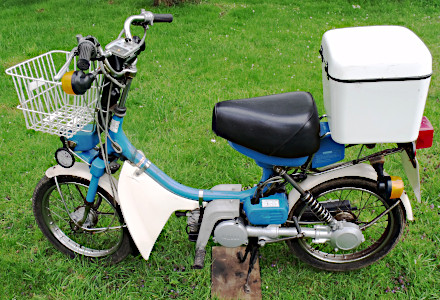
It seems the same market conditions that spawned Honda’s Express also led Yamaha to follow with their own comparable commuter/shopper moped with 14-inch wheels and of very similar design.
The Yamaha Motor Company produced their new QT50 ‘Yamahopper’ moped from 1979—so let’s see what we’ve got this time?
Well, first of all there’s nothing on the bike that actually indicates anything to even suggest it might be called a Yamahopper, so we presume this to be a name only applied in selected markets, but not in the UK where the bike was simply known as the QT50.
QT’s spine chassis is quite skeletal, with cables and wiring threaded through the main tubes to try and keep things tidy, but doesn’t actually achieve much result since everything is so obvious when it emerges at each end. The bike only manages to look bitty and cluttered, like some untidy insect, so there’s no real style to it at all.
Beyond the main tubular components, there’s a random selection of various ‘pods’ disposed in appropriate places to contain or cover essential components.
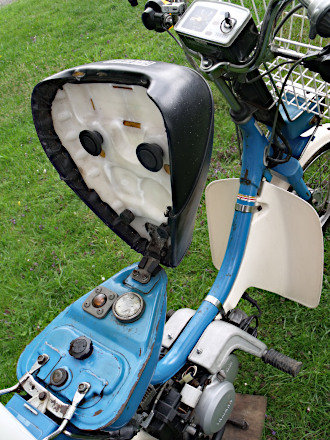
Hinging up the moulded foam single-saddle from its front finds the petrol filler with fuel gauge sight glass set in the top of the tank, and integral pozi-force oil reservoir set to the rear.
To the bottom of the saddle stem, colour co-ordinated plastic carbuncles cover the carburettor & air filter on the left hand side; HT coil, rectifier and other electrical clutter on the right hand side. The battery is housed in a further carbuncle after the seat.
Prominently placed atop the centre of the handlebars is a really naff rectangular speedo box that looks as if it was bought from the budget section of some industrial electrical catalogue, with a 30mph speedo, key-switch off–on–lights, highbeam–turn and two-stroke oil indicators—all very basic.
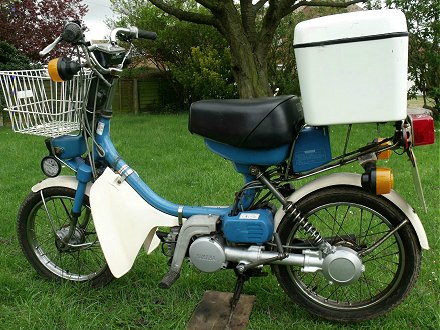
The right handlebar controls are very simply twist-grip throttle and front brake lever, while by comparison, the left hand cluster promises lots of busy action with side & headlight switching, indicator L–off–R, horn button, choke control, and rear brake lever. The rear stop light is operated by control switching from both brake levers.
There’s also a helmet lock clamped to the left handlebar, and a steering lock on the bottom yoke.
Masking the forward steering stem is another naff rectangular black plastic moulded box that looks as if it was adopted from some pond pump equipment from a garden centre catalogue, which houses the horn and a tangled muddle of wiring with electrical connectors.
The short telescopic fork-set with undamped and firm springing offers only a limited 40mm of travel, which is probably adequate to absorb the fiercest shock from hostile bumps, but don’t expect any cloud-floating ride from the front.
The rear suspension comprises an inverted single-sided shock absorber attached at the back hub casing, with the whole engine unit pivoting from its front mount to act as a swinging arm.
The engine is 49cc two-stroke of 40mm bore × 39.2mm stroke rated 2.3 bhp @ 5,500 rpm by reed-valve crankcase induction, driving through single-speed gearing with automatic centrifugal clutch, and transmission to the rear wheel by shaft drive.
Hold on ... Shaft Drive?
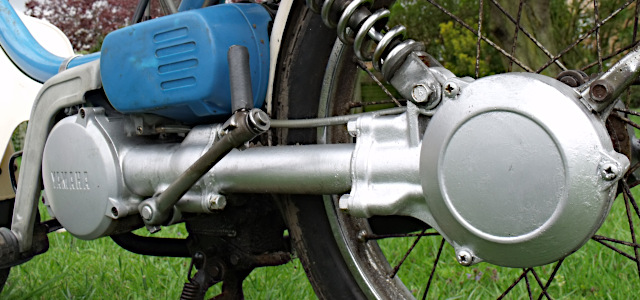
Yes, that’s right, there’s a structural tube connecting the back of the engine to the rear hub casting, and the drive shaft runs within this, sealed from the elements and practically maintenance free.
A general perception normally associates shaft drive with expensive big motor cycle engineering, but here it is on a commuter moped—though admittedly fairly unique.
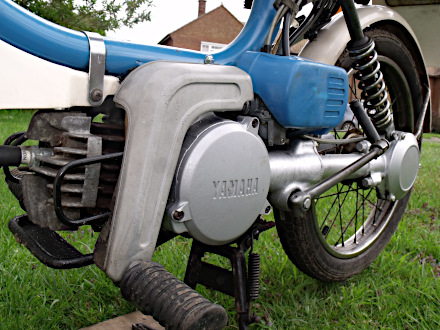
Beyond the crankcase castings, you aren’t really aware of much of the further engine due to plastic moulded footrest trims that practically cover the cylinder barrel. Just the top of the cylinder head peeps from between the covers to allow access to its spark plug.
Our QT dates from 1988, over a decade into the UK ‘sloped’ specification, wears its mandatory 30mph restricted compliance plate, and has its speedo only marked up to 30mph—so guess how we might be expecting it to perform?
A manual fuel tap off–on–reserve operates below the tank, ignition on, trigger a bit of choke just as a token. The kick-starter is arranged scooter fashion, on the left and facing to the rear, but doesn’t concern us greatly since the motor fires up first jab. Running quickly settles, allowing the choke to clear, then navigate to the kerb and assume launch position.
Since there are no pedals on this moped you can’t assist take-off, so nothing to do but wind open the throttle and let the motor do all the work. Initial acceleration is quite sluggish as the automatic clutch feeds in and the small capacity engine labours against the single-speed drive ratio.
Things begin to liven up slightly around 20mph as the revs start to get up, the porting comes on, and the little motor heads toward its typical Yamaha power band—all top end!
The flat crawl up to 20 gives way to some useful performance up to 30, and the engine pulls easily and well in this general working area.
While the motor runs smoothly on revs and there’s no particular awareness of vibration about the cycle frame, the fibreglass moulded back-box delivers a tingling lumbar massage to your lower spine, which makes the rider sit forward from contact after just a couple of minutes.
Chit-chat with the pace bike established QT’s speedo was reasonable accurate, and we wound back the remaining throttle for our first flat run. There seemed a surprising amount of twist-grip to go, but didn’t really expect this to do anything … wrong! QT readily soared beyond the 30mph marker and into no-man’s land! This was uncharted territory on our speedo and beyond rough guesstimation, so we’re now completely reliant on our pace bike’s marking.
Upright position 36, and that wasn’t any flash reading, QT readily achieved this at several points on the flat around the course, so a capable performance—but it didn’t stop there!
In crouch on flat: 38—but it didn’t stop there either!
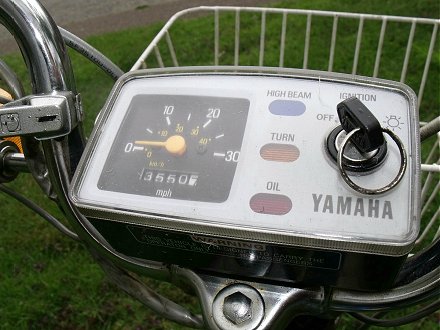
QT’s speedometer is arranged with 0 at 9 o’clock and 30 at 3 o’clock, and divided into three primary graduations of 10mph sectors. In our downhill run, the needle was right down over the mileometer and pointing straight back at the pilot, 6 o’clock position, which the pace bike read at 42mph!
QT revs so hard and super-smooth, you just wonder why it doesn’t blow up!
Its performance hardly seems 30mph compliant in any way, but we’re told by the owner they all go like this and that nothing’s been changed other than the fitment of a C+C pattern exhaust since the original silencers all rot away. This replacement exhaust is certainly no performance system so we really can’t explain why the bike goes so well other than the sloped specification comprising no more than a token plate.
QT also delivered a good account on the following uphill climb, holding well within its power band to crest the rise at a very creditable 29.
Handling could easily become a little twitchy up front and very wallowy at the rear on any bumpy sections and particularly around corners at speed. It wasn’t difficult to find limitations in the suspension at both ends, though the 2.25–14 wheels & tyres proved satisfactory enough as long as the ride was moderated below 30mph.
The forward main frame tube is fitted with a plastic foot-shield set, which only goes up to the bottom yoke, so not really high enough to qualify as proper leg-shields—probably only intended to save your bedroom slippers from getting splashed!
Helped by small wheel physics, brakes at both ends proved reasonably adequate, and they needed to be if you chose to ride it hard.
The DC rectified and battery assisted electrical system makes lights and indicators both stable and bright.
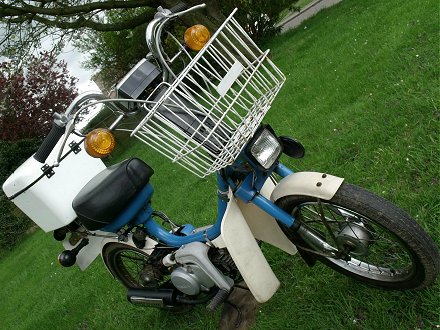
The standard equipment forward and rear carriers allow for simple ‘full shopper conversion’ with easy attachment of front wire basket, rear box, and side panniers as required—practical, but not exactly fashionable.
Much better than chain, the shaft drive offers clean, low maintenance, and low noise transmission, and probably confounds any theory that this might be a power sapping system that is only suitable for large capacity cruisers.
The single-sided rear suspension/drive shaft set-up should theoretically make rear wheel removal very easy, except that you seem to need to take off the complete exhaust system to enable the hub to clear the stub axle, which slightly seems to defeat any advantage in the arrangement. Perhaps it’s just the pattern exhaust at fault?
In summary, the Yamaha QT moped is a minimalist functional shopper with no style whatsoever, and its only interesting feature is the shaft drive—but it does go really well for a supposedly 30mph restricted sloped!
The QT spawned a whole generation of successive spin-off derivatives: YT60 ATV & YF60 Quad bikes, MJ50 Towny two-speed, and PW50 mini-scrambler.
Since many components in the model series are compatible and interchangeable it’s possible to assemble modified combinations using the Towny two-speed crankcase with right side trailing arm, 60cc ATV/quad cylinder & piston set, and high ratio scrambler gears ... then maybe a 15mm or 18mm carburettor conversion and sports exhaust? That’d be really quick for popping down to the shops on—hardly dares thinking about!
After a production run of 13 years, Yamaha discontinued the QT in 1999. Within its time the shaft drive design had become eclipsed by development of the ‘universal scooter’ CVT.
Next—This Italian producer was established in 1950, and continued quite successfully for nearly 40 years, but folks in the UK probably won’t have heard of this make since they hardly seemed to export anything to Britain. Only right at the end, did a handful of their bikes arrive here almost incidentally, and we’re very fortunate to have stumbled across one.
It not only makes an interesting tale, but this feature also tracks off at an unusual tangent as we actually test the same bike twice, in a study on the effects of drive ratio changes, so it’s time to—Get geared-up
This article appeared in the October 2013
Iceni CAM Magazine.
[Text & photographs © 2013 M Daniels. Period
documents from IceniCAM Information
Service.]

